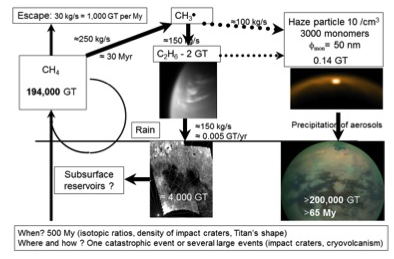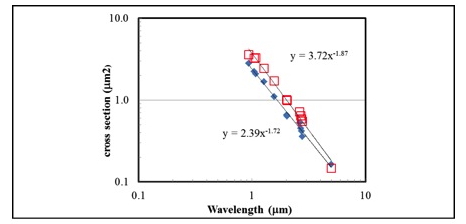2012 Annual Science Report
 NASA Jet Propulsion Laboratory - Titan
Reporting | SEP 2011 – AUG 2012
NASA Jet Propulsion Laboratory - Titan
Reporting | SEP 2011 – AUG 2012
Task 1.1.2.1 Models of the Reaction Between Hydrocarbons and Water Ice (Part 1)
Project Summary
Studying the morphology and composition of Titan’s northern lakes and seas allow refining the values of the carbon contained in different reservoirs (atmosphere, lakes, dune fields). From this a carbon cycle can be constructed that takes into account the interactions between the interior, surface, and atmosphere.
Project Progress
Co-Investigator Christophe Sotin and colleagues have published on the morphology and composition of Titan’s northern lakes and seas (Sotin et al., 2012). This study allows them to refine the values of the carbon contained in the different reservoirs (atmosphere, lakes, and dune fields) and to propose a carbon cycle that takes into account the interactions between the interior, the surface and the atmosphere (Figure 1). Sotin also participated in the study of Ontario Lacus which is the largest lake on the southern polar area (Cornet et al., 2012a, 2012b).
In addition, the improved model of the Schumann resonance in Titan’s cavity provides a value of 65 km (±15 km) for the depth of the ocean (Beghin et al., 2012).
Finally, they are working on the characteristics of aerosols (see Figure 2) and the comparison of the aerosol density profile at the equator and at the pole.

Figure 1: Summary of the carbon reservoirs that are discussed in Sotin et al. (2012). The main reservoirs are the atmospheric methane and the surface dunes. Additional reservoirs may be present in the subsurface and in the deep interior. The transformation from the original methane to the dune final product implies the formation of ethane and subsequent formation of aerosols. The amount of ethane in the atmosphere is small compared to the amount estimated in the lakes. Ethane may substitute to methane in the subsurface (Choukroun and Sotin, 2012), providing partial replenishment in atmospheric methane.

Figure 2: The wavelength dependence of the cross-section is a power law with a slope of -1.8. By comparison with the Huygens observations, it provides a density profile that peaks at 80 km altitude with a number density of 5 cm-3. Ongoing work is pursued to link the value of the cross-section with physical and chemical parameters by comparing the optical properties measured by VIMS with those obtained in laboratories. Blue diamonds and empty red squares correspond to solar occultation observations at the South Pole and at the equator, respectively.
Publications
-
Béghin, C., Randriamboarison, O., Hamelin, M., Karkoschka, E., Sotin, C., Whitten, R. C., … Simões, F. (2012). Analytic theory of Titan’s Schumann resonance: Constraints on ionospheric conductivity and buried water ocean. Icarus, 218(2), 1028–1042. doi:10.1016/j.icarus.2012.02.005
-
Cornet, T., Bourgeois, O., Le Mouélic, S., Rodriguez, S., Lopez Gonzalez, T., Sotin, C., … Nicholson, P. D. (2012). Geomorphological significance of Ontario Lacus on Titan: Integrated interpretation of Cassini VIMS, ISS and RADAR data and comparison with the Etosha Pan (Namibia). Icarus, 218(2), 788–806. doi:10.1016/j.icarus.2012.01.013
-
Cornet, T., Bourgeois, O., Le Mouélic, S., Rodriguez, S., Sotin, C., Barnes, J. W., … Nicholson, P. D. (2012). Edge detection applied to Cassini images reveals no measurable displacement of Ontario Lacus’ margin between 2005 and 2010. Journal of Geophysical Research: Planets, 117(E7), n/a–n/a. doi:10.1029/2012je004073
-
Sotin, C., Lawrence, K. J., Reinhardt, B., Barnes, J. W., Brown, R. H., Hayes, A. G., … Stephan, K. (2012). Observations of Titan’s Northern lakes at 5μm: Implications for the organic cycle and geology. Icarus, 221(2), 768–786. doi:10.1016/j.icarus.2012.08.017
-
PROJECT INVESTIGATORS:
-
RELATED OBJECTIVES:
Objective 2.2
Outer Solar System exploration
Objective 3.1
Sources of prebiotic materials and catalysts
